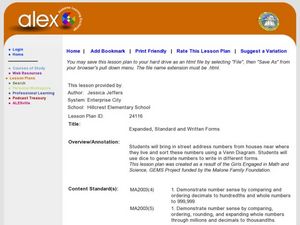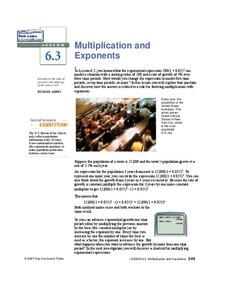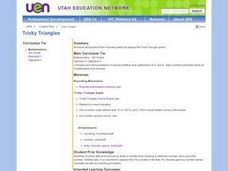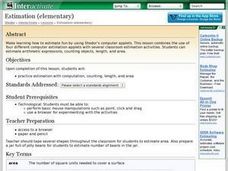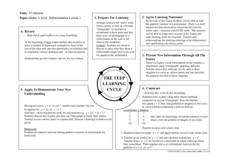Curated OER
Expanded, Standard and Written Forms
Students explore expanded, standard, and written forms of numbers. In this number sense lesson, students examine the various ways of writing numbers as they complete a Venn diagram activity.
Curated OER
Getting to Know You
Students create survey questions for their classmates. In this survey lesson, students pick a yes or no question and find what fraction of the class responded yes. They discover how the wording of a survey question can affect the...
Curated OER
Multiplication and Exponents
Students write values as both standard and exponential forms. In this exponential form lesson, students solve multiplication of exponents problems. Both application and drill and practice formats are presented.
Curated OER
Team Up
Students discover how to break into equal teams. In this dividing lesson, students break different numbers of people into equal groups. Students draw pictures to represent their division and discuss what to do when an equal division...
Curated OER
Pumpkin Seed Experiment
In this unique activity students participate in a pumpkin seed experiment. Students interact with the pumpkins weight, seeds and record their findings of what lies within the pumpkin once the top of the pumpkin is cut off for...
Curated OER
Measure the Angle
Students measure angles. In this angle lesson plan, students draw angles. They use a protractor to measure angles and identify the angle as straight, right, acute, or obtuse.
Curated OER
Too Many Tens
Students practice grouping in different ways by putting numbers up to 1,000 in the correct place value. In this place value lesson plan, students estimate items in a jar and then count them out by grouping them by 10s.
Curated OER
Equivalent forms of Fractions
Fourth graders use kidspiration software to demonstrate understanding of the concept of equivalent fractions. Using a combination of manipulatives, computer software and writing teachers can easily assess student mastery of number sense.
Curated OER
Rolling For Value
Students participate in a activity to comprehend the concept of probability while rolling dice. They recognize patterns while making observations and recording the data for each roll. Students also review place values while playing a...
Curated OER
Tricky Triangles
Third graders engage in a instructional activity that is concerned with the playing of a Trick Triangle Game while focusing upon developing skills of addition, subtraction, multiplication, and division. They play the game and practice...
Curated OER
Making Sense of Density
Students identify the concepts of density, mass, and volume that define the property of a substance. They also determine that the properties of materials, such as, density and volume, can be compared and measured by using rulers,...
Mathematics Assessment Project
Representing 3-D Objects in 2-D
How does the shape of the surface of water in a container change as water leaks out? After tackling this question, learners take part in a similar activity with more complex figures.
Curated OER
In Touch with Apples
Students read "How To Make an Apple Pie and See the World", the story of a girl who traveled the world to find the ingredients to make her apple pie. They conduct a series of interdisciplinary activities including testing their senses,...
Gwinnett County Public Schools
Analysis of the Tuck Everlasting and The Birchbark House Text Exemplars
Looking to introduce some text-based questions into your ELA lessons? Practice the kinds of skills the Common Core demands with the seven text-based questions and the essay prompt provided here. Designed to be a three-day lesson, day one...
Japan Society
Changing Times, Changing Styles: New Japanese Literary Styles of the Late Nineteenth Century
Focusing on Doppo's "Unforgettable People" and late nineteenth century Japanese literature, this resource also leads to discussions of form being dictated by content. Explore the development of new literary styles first-hand by...
Curated OER
Moebius Strips
Students make Moebius strips and use them to demonstrate the interconnectedness of an environment. They explore the natural cycles (water, oxygen/carbon dioxide, carbon, nitrogen) within the environment. They describe how the cycles are...
Curated OER
Estimation Lesson Plan
Students use four different computer estimation applets with several classroom estimation activities.
Curated OER
Do You Have Number Sense?
Seventh graders are grouped according to their ability level with a captain who is elected by the students in that particular group. Students demonstrate their knowledge of rational and irrational numbers by defining them. Students use a...
Curated OER
Writing and Graphing Functions
Pupils explore mathematics by completing a graphing assignment in class. In this math functions lesson, students practice graphing X and Y coordinates on a graph and checking their work with partners. Pupils complete more graphing...
Curated OER
Basic Sense
Fifth graders add fractions. After a class discussion on real life application of fractions, the teacher uses fractions strips to model adding fractions. In pairs, 5th graders model adding fractions by drawing diagrams. They justify...
Curated OER
Math- A Level Differentiated Lesson
Students investigate the gradient function of a polynomial and they conduct a class discussion about its meaning. Then students use graphing software in order to examine tangents that can be seen visually to aid those who need visual...
Curated OER
Math: Counting on Others
Students use counting skills to decide who wins the Classroom Winter Games. They use numeral writing and tally marks to keep score. Students have an opportunity to pretend they are competing for medals in the Winter Games while using...
Curated OER
Riddle Me Cents!
Students use their creativity and logic skills as well as their knowledge of coin values and history to solve a variety of riddles. The lesson prompts students to compose their own riddles, exchange them with classmates, and solve them.
Curated OER
Go Negative
Fourth graders advance to new levels in the lesson we're dealing with here. It is the fourth of a sequence of six dealing with the same theme. These develop from Level 2 to Level 5. In the process they involve number concepts at the...
